Colchester Harbour to Rondeau Harbour
Lake Erie
Sunday, June 26
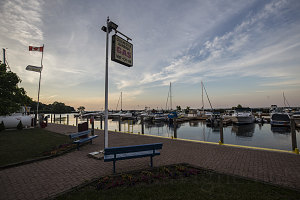
Colchester Harbour
Sunday the 26th (our third day out from Bayfield) dawned with a bit of high haze, but once again, mostly sunny. We were up quite early, and were essentially ready to head out before 7 a.m. We briefly entertained thoughts of just hightailing it out of Colchester harbour without paying the mooring fee, but in the end we went over to the small marina office to pay up. In the light of day, we saw the full extent of the mayfly phenomenon, as literally millions of them coated every surface in sight, and on the ground, drifts of them were piling up. We had arrived precisely at the moment of one of the so-called 'hatching events' of this particular mayfly species - a not uncommon occurrence in this area of the Great Lakes. The span of time is incredibly short - only a few days long - and then they are gone (well, more accurately, dead and gone). The spectacle of biology does not go unnoticed by the captain:
"Mayflies everywhere cracking underfoot. Staff are using a leaf blower and shovels to carve a path through the bodies. Apparently the swarms are so thick, they're being picked up by weather radar."
Simply Blue at Colchester
We pushed off around 7 a.m., electing to have our breakfast out on the water while making progress. Speaking of progress, today's objective was to make best speed possible eastward, roughly paralleling the northern shores of Lake Erie. Although the smallest by volume of the Great Lakes, Lake Erie is still pretty long, coming in at 388 kilometres (or 209 nautical miles for the seafaring among you). We had come into the lake quite close to its western end, and our exit out of the lake was pretty close to its eastern end. That meant a pretty long ride, and with an effective top speed of perhaps 8 or 9 knots, Simply Blue was gonna take its sweet ol' time covering that distance. A time not measured in hours, but rather days.
We carefully negotiated out of the shallow and weedy waters of the marina, and out past the breakwater into Lake Erie. As we motored further out into the lake in preparation of unfurling the sails, we were startled by an alarm from
Simply Blue's engine panel as Roland reduced the throttle to idle. It appeared that the oil pressure had fallen to dangerously low levels. I suggested to Roland that operating the engine with insufficient oil pressure was not wise, and we immediately cut the ignition. For the moment, there was nothing to be done, and we were in position to raise the sails, which we do. Soon things were trimmed and we were moving along eastward at 4 to 5 knots (9-ish km/hr) under a south wind. Roland expressed his own alarm later in the captain's log, noting:
"Motoring out of Colchester harbour, the engine oil pressure light and alarm came on. Not sure what it is this time. WTF."

Breakfast on the go
The winds soon intensified, and by 8 a.m., we are consistently managing 10.5 to 11.5 km/hr (6 knots) - a very reasonable average speed, especially considering that we were able to maintain exactly the course we desired. Attendant to the winds were significantly increased wave heights, probably in excess of a metre. The combination of the height, their period, and the direction made for a long, deep, repeating figure-eight motion of the boat. With our stable configuration and no foreseeable change for several hours, we engaged Simply Blue's autopilot and let it manage the repeated changes in the rudder that were required to maintain course.

Lake Erie Fishery
I went below to spend some time reviewing the engine manual and thinking about what might be causing our latest issue. With the pronounced pitching and rolling of the boat, Roland called down to ask if I was getting seasick while sitting and reading below-deck. Although I could feel that my brain was 'thinking' about what to do with these weird disparities between motion and vision, it never truly rose to the point where I felt sick. Even that slight feeling seemed to fade away as the morning progressed. This wasn't especially surprising, since I've never known myself to be prone to motion sickness; in fact, I can't remember the last year - no, decade - that I threw up.
Anyhow, back to the engine troubles. After reviewing the manual for our 'Heat Exchanger & Keel Cooled 3-cylinder Beta Marine 30' diesel engine (by the end of the trip, I became quite familiar with this manual), and after some time theorizing about our symptoms, I postulated that what we may have experienced was a case of oil frothing - something that can occur when the oil level in the engine is too high. This is caused by the crankshaft hitting and whipping the oil into a bubbly froth. This can reduce the overall viscosity of the oil, and that was perhaps what we had encountered this morning. Perhaps the level had been just a bit too high, and - combined with a bit of pitching motion from waves - had caused the frothing and the resultant low oil pressure at idle, when oil pressure is already naturally somewhat low.
I subsequently pulled the hatch steps to access the engine compartment and check the oil level. I found (perhaps somewhat unfortunately) that it was just slightly below the high mark - meaning that it was basically at the ideal level. Not being any sort of expert on marine engine systems, I wasn't sure how much a pitching motion might cause frothing even at a normal oil level, but overall my confidence in my assessment was a bit uncertain now. I replaced the engine cover and mused about other possible causes for the remainder of the day. We'd have to run some more tests to try and characterize the issue. For now, though, the winds were strong and from the right direction, and our propulsive needs were being met by mother nature. The engine could wait for another time.
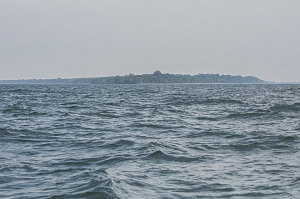
Point Pelee
By 10 a.m. we were approaching a distinctive point of forested land, a point that stuck way out into Lake Erie like a spike. This was Point Pelee, Canada's southernmost point (not counting nearby islands). Did you know that this point is further south than the northern border of California? Not many do.
Carefully avoiding the shallows that project far out from its tip, we rounded Point Pelee and made a 30-degree to port (left) adjustment in our course, as we continued to parallel the northern shore of Lake Erie. The new direction is slightly less favorable for us, and our speed dropped back by a knot or two.
Our speed gradually picked back up as we continued, now in a northeasterly direction, along Lake Erie. Wave heights were now solidly in the 1.5 metre range, and there were frequent whitecaps. Simply Blue seemed to handle it all quite well, although the somewhat primitive autopilot was now furiously adjusting the helm with many little robot-like jerks. By 3pm, we were motoring along consistently at 7+ knots (13 km/hr). Occasionally, when we rode a big wave for a bit, I could see the speed readouts hit 9. nice.
Great spangled fritillary
Roland suggested that we aim for a spot a third of the way along Lake Erie's northern shoreline called Rondeau Harbour. The harbour is a large multi-kilometre feature, formed naturally by the deposition of a thick barrier beach that curves out from the shoreline. Behind it, a shallow and generally calm body of water rests, waiting to safely accommodate recreational marine traffic.
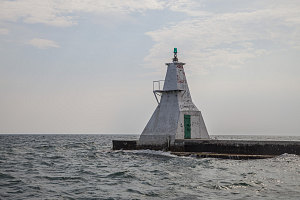
courtesy RHanel
Port-Hand entrance marker
Our progress had been better than expected, and we arrived at the well-marked and dredged entrance to Rondeau Harbour at 5pm. We lowered the sails and motored into Rondeau Harbour, soon exchanging the big rollers of the lake for the small riffles of the harbour. We anxiously watched the engine gauges as we motor in, but we aren't under power for very long and we don't get a repeat of the low oil warning from this morning. We were cautiously optimistic about our frothing diagnosis, but felt more checks were in order. Soon we picked an anchorage spot well away from other craft and in a shallow part of the harbour (most of it is quite shallow, actually).
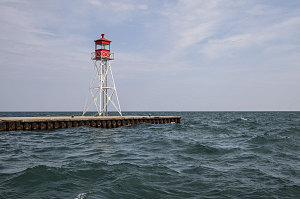
courtesy RHanel
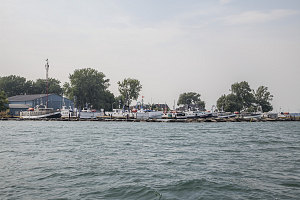
courtesy RHanel

courtesy RHanel
Rondeau Starboard Entrance
We pulled the engine cover and did another fluid check, this time including coolant and transmission fluids. All looked normal. We did an engine run at anchor, noting fairly normal readings for pressure and temperature. We then wondered about some of the shallow, weedy water we'd had to motor in. Was perhaps something binding or clogged underneath? Fortunately, it was a beautifully warm summer evening, and it didn't take much convincing to go for a combination swim and inspection in the shallow waters of Rondeau Harbour. It is had been several days since a shower, and it felt cleansing to go for a swim (and I washed my hair at the same time). Roland did indeed find a bunch of grassy debris wrapped around the prop shaft and propeller, and spent some time underwater to clean it all away.

courtesy RHanel
We returned topside to have dinner and enjoy our relatively early evening. As we prepared our food, a bout of stormy weather passed through, pelting us with some brief rain squalls and a bit of lightning and thunder. The range of light, tones, colors, and textures in the sky above us were tremendously varied and beautiful. All of it died away into the most crimson of sunsets, silhouetting a bank of wind turbines, ceaselessly churning out megawatts of power into Ontario's electrical grid.
Nighty night for Simply Blue
Click below to watch a video wrap-up for June 26:
Video wrap-up for June 26
Interactive trackmap with photo points - Colchester Hrbr to Rondeau Hrbr - click map to view
June 26 - Colchester Hrbr. to Rondeau Hrbr.
Start Time:
7:00a.m.
End Time:
5:24p.m.
Duration:
10h23m
Distance:
103.4 km
(64.25 mi)
Average Speed:
10.0 km/hr
(6.2 mph)
Start Elevation:
575ft
(175m)
*
Max Elevation:
597ft
(182m)
*
Min Elevation:
557ft
(170m)
*
End Elevation:
581ft
(177m)
*
* : +/- 75 feet
Total Elevation Gain:
92ft
(28m)
*
Total Elevation Loss:
82ft
(25m)
*
* : +/- 75 feet
Elevation Graph